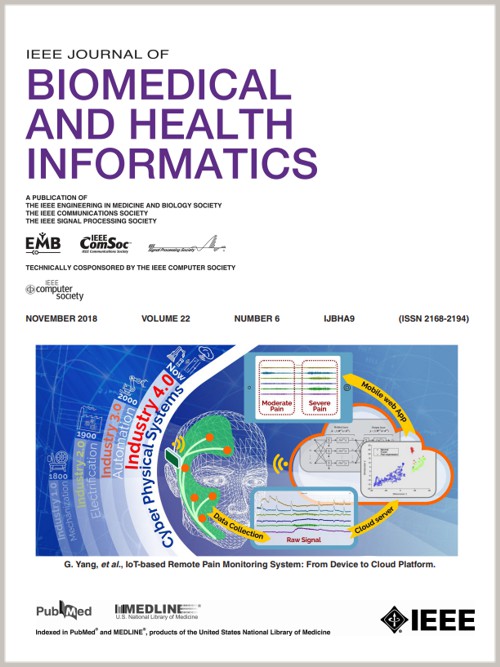利用纵向 sMRI 通过病变特征选择进行早期阿尔茨海默病预测的注意力引导 3D CNN。
IF 6.8
2区 医学
Q1 COMPUTER SCIENCE, INFORMATION SYSTEMS
IEEE Journal of Biomedical and Health Informatics
Pub Date : 2024-10-16
DOI:10.1109/JBHI.2024.3482001
引用次数: 0
摘要
预测从轻度认知障碍(MCI)到阿尔茨海默病(AD)的进展对于早期干预至关重要。为此,各种深度学习模型已被应用于这一领域,它们通常依赖于单个时间点的结构性磁共振成像(sMRI)数据,而忽略了大脑结构随时间的动态变化。目前的纵向研究对疾病的动态演化探索不足,且计算复杂度高。本文介绍了一种新型轻量级三维卷积神经网络,专门用于捕捉脑部疾病的演变过程,为 MCI 的进展建模。首先,本文提出了一种纵向病变特征选择策略,从时间数据中提取核心特征,便于检测两个时间点之间大脑结构的细微差别。接下来,为了完善模型,使其更加侧重于病变特征,引入了疾病趋势关注机制,以学习整体疾病趋势和局部变异特征之间的依赖关系。最后,采用疾病预测可视化技术来提高最终预测结果的可解释性。广泛的实验证明,所提出的模型在曲线下面积(AUC)、准确率、特异性、精确度和 F1 分数方面都达到了最先进的水平。这项研究证实了我们的早期诊断方法的有效性,仅利用两次随访 sMRI 扫描就能预测 MCI 患者 24 个月后的疾病状态,AUC 为 79.03%。本文章由计算机程序翻译,如有差异,请以英文原文为准。
Attention-Guided 3D CNN With Lesion Feature Selection for Early Alzheimer's Disease Prediction Using Longitudinal sMRI
Predicting the progression from mild cognitive impairment (MCI) to Alzheimer's disease (AD) is critical for early intervention. Towards this end, various deep learning models have been applied in this domain, typically relying on structural magnetic resonance imaging (sMRI) data from a single time point whereas neglecting the dynamic changes in brain structure over time. Current longitudinal studies inadequately explore disease evolution dynamics and are burdened by high computational complexity. This paper introduces a novel lightweight 3D convolutional neural network specifically designed to capture the evolution of brain diseases for modeling the progression of MCI. First, a longitudinal lesion feature selection strategy is proposed to extract core features from temporal data, facilitating the detection of subtle differences in brain structure between two time points. Next, to refine the model for a more concentrated emphasis on lesion features, a disease trend attention mechanism is introduced to learn the dependencies between overall disease trends and local variation features. Finally, disease prediction visualization techniques are employed to improve the interpretability of the final predictions. Extensive experiments demonstrate that the proposed model achieves state-of-the-art performance in terms of area under the curve (AUC), accuracy, specificity, precision, and F1 score. This study confirms the efficacy of our early diagnostic method, utilizing only two follow-up sMRI scans to predict the disease status of MCI patients 24 months later with an AUC of 79.03%.
求助全文
通过发布文献求助,成功后即可免费获取论文全文。
去求助
来源期刊

IEEE Journal of Biomedical and Health Informatics
COMPUTER SCIENCE, INFORMATION SYSTEMS-COMPUTER SCIENCE, INTERDISCIPLINARY APPLICATIONS
CiteScore
13.60
自引率
6.50%
发文量
1151
期刊介绍:
IEEE Journal of Biomedical and Health Informatics publishes original papers presenting recent advances where information and communication technologies intersect with health, healthcare, life sciences, and biomedicine. Topics include acquisition, transmission, storage, retrieval, management, and analysis of biomedical and health information. The journal covers applications of information technologies in healthcare, patient monitoring, preventive care, early disease diagnosis, therapy discovery, and personalized treatment protocols. It explores electronic medical and health records, clinical information systems, decision support systems, medical and biological imaging informatics, wearable systems, body area/sensor networks, and more. Integration-related topics like interoperability, evidence-based medicine, and secure patient data are also addressed.
 求助内容:
求助内容: 应助结果提醒方式:
应助结果提醒方式:


